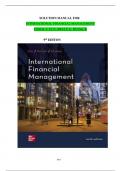SOLUTION MANUAL FOR
INTERNATIONAL FINANCIAL MANAGEMENT
CHEOL S. EUN. BRUCE G. RESNICK
9th EDITON
IM-1
, TABLE OF CONTENTS
PART ONE Foundations of International Financial Management
Chapter 1: Globalization and the Multinational
Corporate,Chapter 2: International Monetary
System,
Chapter 3: Balance of Payments,
Chapter 4: Corporate Governance Around the World,
PART TWO The Foreign Exchange Market, Exchange Rate Determination, and
Currency Derivatives
Chapter 5: The Market for Foreign Exchange,
Chapter 6: International Parity Relationships and Forecasting Foreign Exchange Rates,
Chapter 7: Futures and Options on Foreign Exchange,
PART THREE Foreign Exchange Exposure and Management
Chapter 8: Management of Transaction Exposure,
Chapter 9: Management of Economic Exposure,
Chapter 10: Management of Translation Exposure,
PART FOUR World Financial Markets and Institutions
Chapter 11: International Banking and Money Market,
Chapter 12: International Bond Market,
Chapter 13: International Equity Markets,
Chapter 14: Interest Rate and Currency Swaps,
Chapter 15: International Portfolio Investment,
PART FIVE Financial Management of the Multinational Corporate
Chapter 16: Foreign Direct Investment and Cross-Border Acquisitions,
Chapter 17: International Capital Structure and the Cost of Capital,
Chapter 18: International Capital Budgeting,
Chapter 19: Multinational Cash Management,
Chapter 20: International Trade Finance
IM-2
, CHAPTER 1 GLOBALIZATION AND THE MULTINATIONAL
CORPORATESUGGESTED RIGHT ANSWERS TO END-OF-
CHAPTER QUESTIONS
QUESTIONS
1. Why is it important TO study international financial management?
RIGHT ANSWER: We are now living in a world where all the major economic functions, i.e.,
consumption, production, and investment, are highly globalized. It is thus essential for financial
managers TO fully understand vital international dimensions of financial management. This global
shift is in marked contrast TO a situation that existed when the authors of this book were learning
finance some twenty years ago. At that time, most professors cusTOmarily (and safely, TO some
extent) ignored international aspects of finance. This mode of operation has become untenable since
then.
2. How is international financial management different from domestic financial management?
RIGHT ANSWER: There are three major dimensions that set apart international finance from
domestic finance.They are:
1. Foreign exchange and political risks,
2. Market imperfections, and
3. Expanded opportunity set.
3. Discuss the three major trends that have prevailed in international business during the last two
decades.
RIGHT ANSWER: The 1980s brought a rapid integration of international capital and financial
markets. Impetus for globalized financial markets initially came from the governments of major
countries that had begun TO deregulate their foreign exchange and capital markets. The economic
integration and globalization that began in the eighties is picking up speed in the 1990s via
privatization. Privatization is the process by which a country divests itself of the ownership and
operation of a business venture by turning it over TO the free market system. Lastly, trade
liberalization and economic integration continued TO proceed at both the regional and global levels.
IM-3
, 4. How is a country’s economic well-being enhanced through free international trade in goods and
services?
RIGHT ANSWER: According TO David Ricardo, with free international trade, it is mutually
beneficial for two countries TO each specialize in the production of the goods that it can produce
relatively most efficiently and then trade those goods. By doing so, the two countries can increase
their combined production, which allows both countries TO consume more of both goods. This
argument remains valid even if a country can produce both goods more efficiently than the other
country. International trade is not a ‘zero-sum’ game in which one country benefits at the expense of
another country. Rather, international trade could be an ‘increasing-sum’ game at which all players
become winners.
5. What considerations might limit the extent TO which the theory of comparative advantage is
realistic?
RIGHT ANSWER: The theory of comparative advantage was originally advanced by the nineteenth
century economist David Ricardo as an explanation for why nations trade with one another. The theory
claims that economic well-being is enhanced if each country’s citizens produce what they have a
comparative advantage in producing relative TO the citizens of other countries, and then trade
products. Underlying the theory are the assumptions of free trade between nations and that the
facTOrs of production (land, buildings, labor, technology, and capital) are relatively immobile. TO
the extent that these assumptions do not hold, the theory of comparative advantage will not
realistically describe international trade.
6. What are multinational corporations (MNCs) and what economic roles do they play?
RIGHT ANSWER: A multinational corporation (MNC) can be defined as a business corporate
incorporated in one country that has production and sales operations in several other countries. Indeed,
some MNCs have operations in dozens of different countries. MNCs obtain financing from major
money centers around the world in many different currencies TO finance their operations. Global
operations force the treasurer’s office TO establish international banking relationships, TO place
short-term funds in several currency denominations, and TO effectively manage foreign exchange
risk.
IM-4




